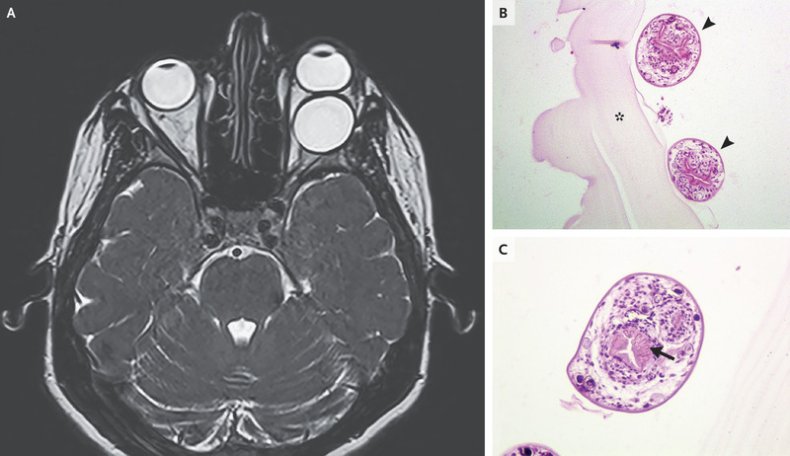Woman's Eye Bulging from Socket Was Caused by a Baby Tapeworm-filled Cyst - Newsweek
Woman's Eye Bulging from Socket Was Caused by a Baby Tapeworm-filled Cyst - Newsweek |
| Woman's Eye Bulging from Socket Was Caused by a Baby Tapeworm-filled Cyst - Newsweek Posted: 02 Apr 2020 04:38 AM PDT A woman who had experienced blurred vision was found to have a cyst filled with baby tapeworms behind her swollen eye. The 31-year-old woman was admitted to the hospital after suffering from "progressive bulging of the left eye" for two weeks. She had also had blurred vision for almost a month when she arrived at the emergency department of a hospital in Greece. Her case has now been reported in the NEJM by doctors Stelios F. Assimakopoulos and Markos Marangos, of the University of Patras, Greece. After an initial examination, the physicians found her protruding eye to be nontender. She had partial paralysis of the left abducens nerve, which controls the movement of one of the eye muscles. An MRI scan showed a large, egg-shaped cyst in the orbital cavity, and this appeared to have displaced the optic nerve. It had also compressed the muscle involved in eye movement. Doctors surgically removed the cyst but it burst during the operation, so the team had to wash the cavity with saline.  They then examined the cyst and found multiple protoscolices, the pre-stage of the development of the Echinococcus granulosus tapeworm. These protoscolices were found to have hooklets attached to the cyst membrane. They diagnosed it as a hydatid cyst. Panel C shows the hooklets of the protoscolices. Hydatid disease is recorded across the world. While the tapeworm itself is small, the juvenile form of the parasite can lead to the development of large cysts in different organs. This is most common in the liver and lungs. However, Australia's Queensland Museum notes it can also occur in the spleen, kidneys and sometimes the brain. Assimakopoulos told Newsweek that around 60 to 70 percent of cases of cysts from Echinococcus granulosus are found in the liver. He said less than 1 percent occur behind the eye, as the case reported. The U.S. Centers for Disease Control and Prevention, Echinococcus granulosus tend to enter humans via feces that have tapeworm eggs in it. The tapeworm embryo are released into the intestine where they hatch and release hooks that penetrate the intestinal wall. They can then migrate through the blood to reach various organs, where the cysts develop. Normally, for an adult tapeworm to develop the cyst has to be ingested by another animal. When in the intestine, it develops into an adult from 32 to 80 days. If a cyst ruptures before being ingested, secondary cysts can develop in other organs. Humans are occasionally accidentally infected by oral ingestion of tapeworm eggs with contaminated food or water or direct contact with host," Assimakopoulos said. "The eggs hatch after digestion of the outer capsule in the intestinal mucosa and the larvae penetrate the mucosa, reaching the liver first and the lungs afterwards. If these two filters (liver and lungs) are not involved and there is an unusual localization of cysts, systemic dissemination through lymphatic route is a strong possibility." The woman was given a three month course of albendazole, a drug that is used to treat a variety of parasitic worm infestations. After three months her vision had fully recovered, Assimakopoulos and Marangos wrote. This article has been updated to include quotes from Stelios F. Assimakopoulos. |
| You are subscribed to email updates from "How would I know if I had a tapeworm" - Google News. To stop receiving these emails, you may unsubscribe now. | Email delivery powered by Google |
| Google, 1600 Amphitheatre Parkway, Mountain View, CA 94043, United States | |
Comments
Post a Comment